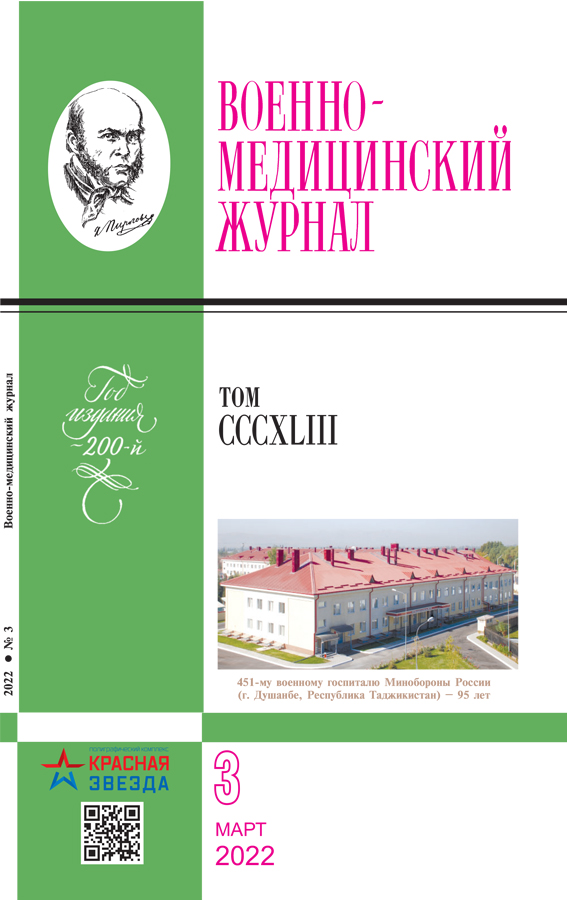Functional visual impairment and methods of its detection
- Authors: Egorov A.N.1, Kamenkova E.A.2, Egorov V.A.2, Pravil’nikova P.A.1
-
Affiliations:
- 12th Consultative and Diagnostic Center of the Ministry of Defense of the Russian Federation
- The N.I. Pirogov City Clinical Hospital No. 1 of the Moscow City Health Department
- Issue: Vol 343, No 3 (2022)
- Pages: 48-60
- Section: Treatment and prophylactic issues
- URL: https://journals.eco-vector.com/0026-9050/article/view/629746
- DOI: https://doi.org/10.52424/00269050_2022_343_3_48
- ID: 629746
Cite item
Abstract
The purpose of the work was to assess the effectiveness of control methods for studying visual acuity disorders and to select the most optimal modifications of them in compliance with the conditions for use during the medical examination. According to our data, the Vick test turned out to be the least effective – 30% of positive results. The method of studying visual acuity from different distances was positive in 43%, methods of research with separate signs and with flat glass – in almost 50% of the examined. The most effective were the studies of visual acuity using the Polyak table, the «mirror» test, and the study with individual signs (Polyak optotypes) – 90.5%, 93.9%, and 82.8%, respectively. A thorough examination is required from an ophthalmologist to establish the true state of visual functions and exclude the organic nature of the disorders. Anamnestic verification is often essential to an expert opinion. In case of complaints of blindness in both eyes or lack of object vision, the subjects are subject to observation and examination in stationary conditions.
Keywords
About the authors
A. N. Egorov
12th Consultative and Diagnostic Center of the Ministry of Defense of the Russian Federation
Author for correspondence.
Email: kamen77@list.ru
заслуженный врач РФ, кандидат медицинских наук, полковник медицинской службы в отставке
Russian Federation, MoscowE. A. Kamenkova
The N.I. Pirogov City Clinical Hospital No. 1 of the Moscow City Health Department
Email: kamen77@list.ru
кандидат медицинских наук
Russian Federation, MoscowV. A. Egorov
The N.I. Pirogov City Clinical Hospital No. 1 of the Moscow City Health Department
Email: kamen77@list.ru
Russian Federation, Moscow
P. A. Pravil’nikova
12th Consultative and Diagnostic Center of the Ministry of Defense of the Russian Federation
Email: kamen77@list.ru
Russian Federation, Moscow
References
- Авербах М.И. Офтальмологические очерки. – М., 1940. – С. 165–188.
- Балтин М.М. Проба Фалта для определения односторонней слепоты, резкого понижения зрения на одном глазу и симуляции таковых // Вестн. офтальмол. – 1944. – Т. 23, Вып. 4. – С. 22–24.
- Беллярминов Л.Г., Мерц А.И. Глазные болезни. – Л., 1930. – Ч. 3 – С. 1075–1085.
- Васютинский А.Г. Симуляция слепоты и ослабления зрения // Воен.-мед. журн. – 1910. – Т. 229; ноябрь, С. 519–532; декабрь, С. 664–709.
- Вишневский И.А. К вопросу отбора стрелков и снайперов со стороны органа зрения // Воен.-санит. дело.– 1930. – № 3. – С. 2–35.
- Волкович Е.П. Данные исследования испытуемых призывников глазного отделения // Воен.-мед. журн. – 1912. – Т. 233. – С. 541–556.
- Головин С.С. Клиническая офтальмология. – 1923. – Т. 3, Гл. 25 «О диагнозе и о симуляциях». – С. 938–964.
- Дислер Н.Н. Об одном способе выявления симуляции сужения поля зрения // Вестн. офтальмол. – 1950. – Т. 29, № 4. – С. 38–39.
- Лонгморе Т. Руководство к исследованию для военных врачей. – СПб, 1894. – 229 с.
- Ковальская А.А., Коскин С.А., Бойко Э.В., Шелепин Ю.Е. Объективное исследование остроты зрения на основе регистрации оптокинетического нистагма с помощью инфракрасной видеоокулографии в целях врачебной экспертизы // Соврем. оптометрия. – 2013. – № 3. – С. 18–24.
- Одинцов В.П. Курс глазных болезней. – М.: Биомедгиз, 1936.
- Пасечникова Н.В. Результаты исследования остроты зрения и клинической рефракции с укороченных дистанций // Офтальмол. журн. – 1986. – № 4. – С. 235–238.
- Стулова А.Н., Семенова Н.С., Акопян В.С. Оценка остроты зрения: взгляд в прошлое и современные тенденции // Вестн. офтальмол. – 2019. – Т. 135, № 6. – С. 142–146.
- Поляк Б.Л. Основы военно-полевой офтальмологии / Наркомздрав СССР. – М.: Медгиз, 1943.
- Шибинская Н.И. Оптокинетический нистагм как метод объективного определения остроты зрения // Офтальмол. журн. – 1957. – № 5. – С. 306–312.
- Шибинская Н.И. Метод объективного определения остроты зрения при различно ширине зрачка // Офтальмол. журн. – 1968. – № 5. – С. 339–342.
- Штрампель А.Х. 3 случая ложной слепоты // Вестн. офтальмол. – 1951. – Т. 30, № 2. – С. 44.
- Duke-Elder S. Text – book of ophthalmology. – London, 1950. – Vol. IV. – P. 3719–3730.
- Falta M. Neuere angaber meine Annhrungsprobe zur Bestimmung einseitiger Blindheit, Schwachsichtigkeit und ihrer simulation // Klin. Monatsbl. f. Augenheilkunde. – 1931. – Bd. 87. – S. 96–104.
- Kоllner H. Die Untersuchung auf Simulation. Handbuch der gesamten Augenheilkunde, 3 auflage , Bd 3 // Die Untersuchungsmethoden. – Berlin:, Verlag von Julius Springer, 1925. – S. 553–660.
- Ohm J. Entwicklung liner Great // Klin. Monatshl. f. Augenheilik. – 1947. – S. 122, 402.
- Thompson H.S. Functional visual loss // Am. J. Ophthalmol. – 1985. – Vol. 100, N 1. – P. 209–213.
Supplementary files







